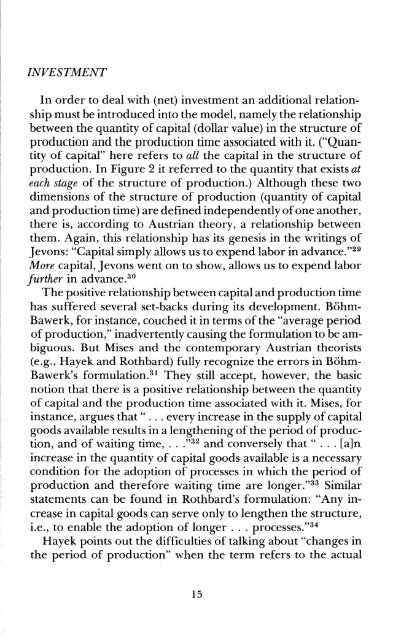Austrian Macroeconomics - Ludwig von Mises Institute
Austrian Macroeconomics - Ludwig von Mises Institute
Austrian Macroeconomics - Ludwig von Mises Institute
Create successful ePaper yourself
Turn your PDF publications into a flip-book with our unique Google optimized e-Paper software.
INVESTMENT<br />
In order to deal with (net) investment an additional relationship<br />
must be introduced into the model, namely the relationship<br />
between the quantity of capital (dollar value) in the structure of<br />
production and the production time associated with it. ("Quantity<br />
of capital" here refers to all the capital in the structure of<br />
production. In Figure 2 it referred to the quantity that exists at<br />
each stage of the structure of production.) Although these two<br />
dimensions of the structure of production (quantity of capital<br />
and production time) are defined independently ofone another,<br />
there is, according to <strong>Austrian</strong> theory, a relationship between<br />
them. Again, this relationship has its genesis in the writings of<br />
Je<strong>von</strong>s: "Capital simply allows us to expend labor in advance."29<br />
More capital, Je<strong>von</strong>s went on to show, allows us to expend labor<br />
further in advance.3 0<br />
The positive relationship between capitaland production time<br />
has suffered several set-backs during its development. B6hm<br />
Bawerk, for instance, couched it in terms ofthe "average period<br />
of production," inadvertently causing the formulation to be ambiguous.<br />
But <strong>Mises</strong> and the contemporary <strong>Austrian</strong> theorists<br />
(e.g., Hayek and Rothbard) fully recognize the errors in B6hm<br />
Bawerk's formulation. 31 They still accept, however, the basic<br />
notion that there is a positive relationship between the quantity<br />
of capital and the production time associated with it. <strong>Mises</strong>, for<br />
instance, argues that" ... every increase in the supply ofcapital<br />
goods available results in a lengthening ofthe period of production,<br />
and of waiting time, ..."32 and conversely that" ... [a]n.<br />
increase in the quantity of capital goods available is a necessary<br />
condition for the adoption of processes in which the period of<br />
production and therefore waiting time are longer."33 Similar<br />
statements can be found in Rothbard's formulation: "Any increase<br />
in capital goods can serve only to lengthen the structure,<br />
i.e., to enable the adoption of longer ... processes."34<br />
Hayek points out the difficulties of talking about "changes in<br />
the period of production" when the term refers to the actual<br />
15

















